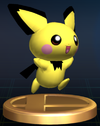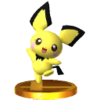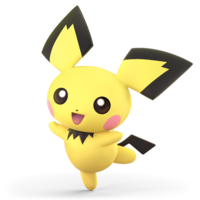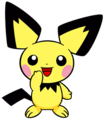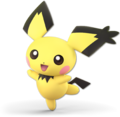Pichu
- For fighter info, see Pichu (SSBM) and Pichu (SSBU).
| Pichu | |
|---|---|
{{{content1}}}
{{{content2}}}  Official artwork of Pichu from Pokémon FireRed and LeafGreen Versions and Spiky-eared Pichu from Arceus and the Jewel of Life. | |
| Universe | Pokémon |
| Debut | Pokémon Gold and Silver Versions (1999) |
| Smash Bros. appearances | Melee Brawl SSB4 (3DS only) Ultimate |
| Most recent non-Smash appearance | Pokémon Brilliant Diamond and Shining Pearl (2021) |
| Console/platform of origin | Game Boy Color |
| Species | Pichu |
| Gender | Varies Female (Spiky-eared) |
| Place of origin | Johto |
| Designed by | Ken Sugimori |
| Voice actor | Satomi Korugi |
| Article on Bulbapedia | Pichu (Pokémon) |
Pichu (ピチュー, Pichu) is the Tiny Mouse Pokémon from the Pokémon series. It debuted in the series' second generation, and is present as a playable character in Super Smash Bros. Melee and Super Smash Bros. Ultimate after being absent from both Super Smash Bros. Brawl and Super Smash Bros. 4.
Origin
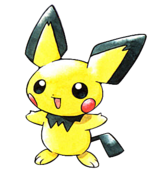
Pichu is a small, rodent-like Pokémon characterized by its yellow fur, flat, triangular ears, and pink cheeks. It is categorized within the Pokédex at #172 as the "Tiny Mouse Pokémon".[1] As both the pre-evolved form of Pikachu and a baby Pokémon, Pichu is much less powerful than its evolved forms. While it cannot learn some moves that Pikachu and Raichu can, it can learn three moves (Charm, Sweet Kiss and Nasty Plot) that its evolved forms couldn't learn until Sword and Shield. Pichu only evolves into Pikachu when it achieves a very high level of friendship with its Trainer.
The Pokédex explains that the electricity pouches in Pichu's cheeks are still small and unable to store much electricity. This, in turn, makes it inexperienced with handling electrical attacks, to the point that it occasionally inflicts damage to itself. While this does not actually occur in the Pokémon games (outside of two instances where it is a universal mechanic), it has nevertheless been demonstrated in the Pokémon anime, in Pokémon Channel and the Super Smash Bros. series.
Pichu's inexperience with handling electricity may also result in spontaneously discharging if amused or startled. Despite its small size, it can zap even adult humans, but surprises itself whenever it does so. When it plays with other Pichu, they may short out electricity with each other, creating a shower of sparks, startling them and causing them to start crying.[1]
Pichu becomes more adept at storing electricity as it grows older, and will start playing with other Pichu by touching tails and discharging sparks in apparent mutual tests of courage. It charges itself with electricity more easily on days that either have very dry air or thunderclouds, in which case the crackling of static electricity can be heard coming off of it.[1]
If the parent of a Pichu holds a Light Ball while the egg is produced, that Pichu will know Volt Tackle when it hatches. This is the only way other than move tutoring for any member of Pichu's evolutionary line to learn Volt Tackle. It is also not an egg move, meaning a parent that knows Volt Tackle is unable to pass the move down to its descendants.
Like Pikachu, Pichu has a special variant of its species; in Pichu's case, it is Spiky-eared Pichu, which debuted in Pokémon HeartGold and SoulSilver. True to her name, Spiky-eared Pichu features three spiky tufts of fur on her left ear. Spiky-eared Pichu also deviates from other members of her species by knowing Helping Hand and Pain Split, having different Pokéathlon stats and, most notably, her inability to evolve or be traded outside HeartGold and SoulSilver and her incompatibility with the Poké Transfer by extension. The latter two traits are later explained by Professor Elm as a side effect of her constantly traveling through time with Celebi.
In Super Smash Bros. Melee
As a playable character
Pichu is a playable unlockable character in Super Smash Bros. Melee. As confirmed in a development news update shortly after Melee's release, Pichu was purposed to be a "joke character" because of its status as an inferior clone of Pikachu that possesses more weaknesses and weaker strengths.[2] Its most infamous flaw is based on its Pokédex description of unintentionally harming itself with its own electricity: whenever Pichu performs an electrical attack, it will sustain 1%-4% recoil damage. Along with this, Pichu is the lightest character in Melee, giving it extremely poor endurance. Although its agility and okay juggling capabilities were more recently highlighted, such positives are insufficient to offset its multitude of cons, resulting in Pichu currently ranking 22nd out of 26 on the Melee tier list in the D tier.
Trophy
A Tiny Mouse Pokémon identifiable by its big ears, Pichu evolves into Pikachu. It's not very skilled at storing up electrical energy and will sometimes discharge it if jarred. Although it's small, it has enough electrical power to give even an adult quite a shock. It's often startled by its own power.
- Pokémon Gold & Silver, 10/00 (GBC)
In Super Smash Bros. Brawl
Pichu is one of the five playable characters in Melee who did not return as a playable character in Super Smash Bros. Brawl, along with Dr. Mario, Mewtwo, Roy and Young Link. It is also the only character who neither has unfinished data on Brawl's disc, nor a new playable character as a successor. Instead, Pichu only appears as a trophy. However, its ability to wall jump and the blue goggles from its blue alternate costume were given to Pikachu.
Trophy
Pichu makes an appearance in Brawl as a collectible trophy. It is obtained by completing All-Star Mode without using a continue. The trophy describes Pichu's appearance in the Pokémon games, and makes no reference whatsoever to its appearance in Melee:
- Pichu
A Tiny Mouse Pokémon. Because its electric cheek pouches are still small, it cannot store electricity yet. Pichu has been known to flaunt its courage by touching tails with others and setting off sparks. It is easier for Pichu to build up electricity when the humidity is lower. Pichu will evolve into Pikachu.
: Pokémon Gold/Silver
: Pokémon Diamond/Pearl
In Super Smash Bros. 4
Once again, Pichu only appears as a trophy in Super Smash Bros. for Nintendo 3DS, while Super Smash Bros. for Wii U references it via Palutena's Guidance regarding Pikachu. Once again, Pikachu still has Pichu’s blue goggles and Pichu’s wall jump.
Trophy
- Pichu
- Professor Elm must have been shocked when he discovered a pre-evolution of Pikachu! These cute baby Pokémon often discharge electricity accidentally when something takes them by surprise. They also play together by using their tails to make sparks fly! It's cute to watch, but it's good training for battle, too.
In Super Smash Bros. Ultimate
As a playable character
After a two-installment absence, Pichu returns as a playable character in Super Smash Bros. Ultimate. This marks its first playable appearance in the Super Smash Bros. series in 17 years, a distinction shared with fellow Melee newcomer Young Link. In addition, Spiky-eared Pichu appears in this game as a playable character via Pichu's alternate costumes. Ultimate also marks her first appearance in any form of official media (video games or otherwise) in nearly a decade. Oddly enough, unlike Pikachu Libre, Spiky-eared Pichu does not have an obtainable Fighter Spirit.
Pichu still functions as a lighter, polarized clone of Pikachu, yet it has nevertheless been somewhat decloned (though not to the same extent as previous clones due to it not receiving as many entirely original moves), thanks to several of its moves having received modified animations, functionality changes and/or frame data adjustments, as well as Pikachu gaining a new neutral aerial. It has also been greatly buffed, due its previous status as a "joke character", and is considered by many to be a viable character even after its nerfs in 3.1.0. Despite the term "Echo Fighter" being used in Ultimate to denote clones, Pichu is not labeled as such, and no official reason has been given for this oddity. However, it is worth noting that clone characters introduced before SSB4 are not labeled as Echo Fighters.
Spirit
Gallery
Names in other languages
| Language | Name |
|---|---|
| ピチュー, Pichu | |
| Pichu | |
| Pichu | |
| Pichu | |
| Pichu | |
| Pichu | |
| 皮丘, Pichu | |
| 피츄, Pichu | |
| Pichu | |
| Пичу | |
| Pichu |
Trivia
- With it debuting in November 1999, Pichu was the most recently debuted fighter at the time of Melee's release (aside from Roy, whose first appearance was in Melee itself).
- Additionally, it is the newest playable fighter in the Super Smash Bros. series to debut in the 20th century.
- Pichu is the only playable character in Smash whose console of origin is the Game Boy Color.
- Pichu is the only playable baby Pokémon.
- It is also the only playable Pokémon to be part of the same evolutionary family as another playable Pokémon.
- It is also the first playable Pokémon not to originate from Generation I.
- The Pichu evolution family is one of three to have its entire family appear in one Super Smash Bros. game. In Ultimate, Pichu and Pikachu are playable characters, and Alolan Raichu appears as a Poké Ball Pokémon. The others are the Riolu evolution family, as Riolu appears as a trophy in Brawl and Lucario debuted as a fighter in said installment, and the Munchlax evolution family, as both Munchlax and Snorlax appear as Poké Ball Pokémon in Brawl.
- Pichu and Squirtle are the only playable Pokémon to be in their first stage of their evolutionary line. Pikachu and Jigglypuff also had this status in the first game, which was released before Pokémon Gold and Silver, in which Pichu itself and Igglybuff displaced them from it.
- Despite Pichu using both Skull Bash and Agility as part of its moveset, Pichu cannot legally learn either move in the Pokémon core series. Interestingly, Pichu also receives recoil damage if it uses these moves, despite Agility's lack of the electric effect, and both moves' inability to cause recoil in their home series.
- In the Pokémon series, the only Electric-type moves that Pichu receives recoil damage from are Volt Tackle (which is also true for its Final Smash version unlike its clone Pikachu) and Wild Charge. This Super Smash Bros.-specific attribute most likely derives from its Pokédex entries, which state that Pichu are "unskilled at storing electric power". It could also be a reference to the Pichu Brothers being overwhelmed by their own electricity, as shown in Pikachu and Pichu.
- Pichu is the only character in any game who takes damage while using their Final Smash.
- Pichu and Young Link are the only playable characters to skip more than one installment in the Super Smash Bros. series prior to returning to the series in a playable capacity.
- Pichu is the only character with non-special attacks which inflict recoil damage.
References
- ^ a b c Pichu | Pokédex
- ^ News Flash! Smash Bros. Dojo: Pichu (translated 2015-09-24; original posted 2001-12-11)
| Non-playable Pokémon in Super Smash Bros. Brawl | |
|---|---|
| Poké Ball | Bellossom · Bonsly · Celebi · Chikorita · Deoxys · Electrode · Entei · Gardevoir · Goldeen · Groudon · Gulpin · Ho-Oh · Jirachi · Kyogre · Latias and Latios · Lugia · Manaphy · Meowth · Metagross · Mew · Moltres · Munchlax · Piplup · Snorlax · Staryu · Suicune · Togepi · Torchic · Weavile · Wobbuffet |
| Stage elements | Pokémon Stadium 2: Cubone · Drifloon · Dugtrio · Electivire · Hoppip · Magnezone · Skarmory · Snorunt · Snover Spear Pillar: Azelf · Cresselia · Dialga · Mesprit · Palkia · Uxie |
| Trophy-only | Blaziken · Bulbasaur · Buneary · Charmander · Chimchar · Cyndaquil · Darkrai · Glaceon & Leafeon · Gyarados · Mewtwo · Mudkip · Pichu · Plusle & Minun · Riolu · Starly · Totodile · Treecko · Turtwig |
| Bosses | Rayquaza |
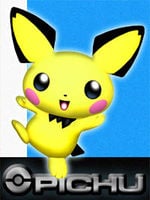
![Pichu [Classic Mode] trophy](https://ssb.wiki.gallery/images/thumb/5/50/Pichu_Trophy_Melee.png/72px-Pichu_Trophy_Melee.png)
![Pichu [Smash, Adventure Mode] trophy](https://ssb.wiki.gallery/images/thumb/f/f7/Pichu_Trophy_%28Smash%29.png/72px-Pichu_Trophy_%28Smash%29.png)
![Pichu [Smash, All-Star Mode] trophy](https://ssb.wiki.gallery/images/thumb/c/c8/Pichu_Trophy_%28Smash_2%29.png/72px-Pichu_Trophy_%28Smash_2%29.png)
